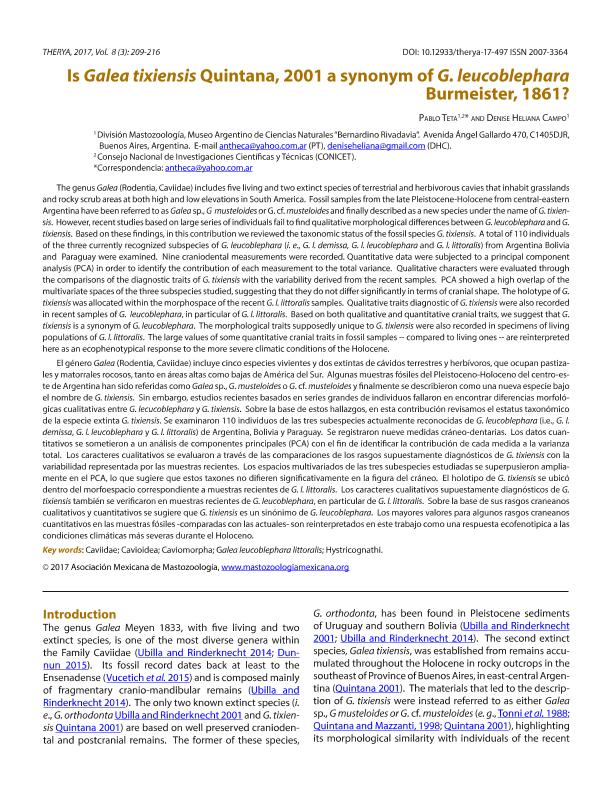Artículo
El género Galea (Rodentia, Caviidae) incluye cinco especies vivientes y dos extintas de cávidos terrestres y herbívoros, que ocupan pastizales y matorrales rocosos, tanto en áreas altas como bajas de América del Sur. Algunas muestras fósiles del Pleistoceno-Holoceno del centro-este de Argentina han sido referidas como Galea sp., G. musteloides o G. cf. musteloides y finalmente se describieron como una nueva especie bajo el nombre de G. tixiensis. Sin embargo, estudios recientes basados en series grandes de individuos fallaron en encontrar diferencias morfológicas cualitativas entre G. lecucoblephara y G. tixiensis. Sobre la base de estos hallazgos, en esta contribución revisamos el estatus taxonómico de la especie extinta G. tixiensis. Se examinaron 110 individuos de las tres subespecies actualmente reconocidas de G. leucoblephara (i.e., G. l. demissa, G. l. leucoblephara y G. l. littoralis) de Argentina, Bolivia y Paraguay. Se registraron nueve medidas cráneo-dentarias. Los datos cuantitativos se sometieron a un análisis de componentes principales (PCA) con el fin de identificar la contribución de cada medida a la varianza total. Los caracteres cualitativos se evaluaron a través de las comparaciones de los rasgos supuestamente diagnósticos de G. tixiensis con la variabilidad representada por las muestras recientes. Los espacios multivariados de las tres subespecies estudiadas se superpusieron ampliamente en el PCA, lo que sugiere que estos taxones no difieren significativamente en la figura del cráneo. El holotipo de G. tixiensis se ubicó dentro del morfoespacio correspondiente a muestras recientes de G. l. littoralis. Los caracteres cualitativos supuestamente diagnósticos de G. tixiensis también se verificaron en muestras recientes de G. leucoblephara, en particular de G. l. littoralis. Sobre la base de sus rasgos craneanos cualitativos y cuantitativos se sugiere que G. tixiensis es un sinónimo de G. leucoblephara. Los mayores valores para algunos rasgos craneanos cuantitativos en las muestras fósiles –comparadas con las actuales– son reinterpretados en este trabajo como una respuesta ecofenotipica a las condiciones climáticas más severas durante el Holoceno. The genus Galea (Rodentia, Caviidae) includes five living and two extinct species of terrestrial and herbivorous cavies that inhabit grasslandsand rocky scrub areas at both high and low elevations in South America. Fossil samples from the late Pleistocene-Holocene from central-easternArgentina have been referred to as Galea sp., G musteloides or G. cf. musteloides and finally described as a new species under the name of G. tixiensis. However, recent studies based on large series of individuals fail to find qualitative morphological differences between G. leucoblephara and G.tixiensis. Based on these findings, in this contribution we reviewed the taxonomic status of the fossil species G. tixiensis. A total of 110 individualsof the three currently recognized subspecies of G. leucoblephara (i. e., G. l. demissa, G. l. leucoblephara and G. l. littoralis) from Argentina Boliviaand Paraguay were examined. Nine craniodental measurements were recorded. Quantitative data were subjected to a principal component analysis (PCA) in order to identify the contribution of each measurement to the total variance. Qualitative characters were evaluated through the comparisons of the diagnostic traits of G. tixiensis with the variability derived from the recent samples. PCA showed a high overlap of the multivariate spaces of the three subspecies studied, suggesting that they do not differ significantly in terms of cranial shape. The holotype of G. tixiensis was allocated within the morphospace of the recent G. l. littoralis samples. Qualitative traits diagnostic of G. tixiensis were also recorded in recent samples of G. leucoblephara, in particular of G. l. littoralis. Based on both qualitative and quantitative cranial traits, we suggest that G. tixiensis is a synonym of G. leucoblephara. The morphological traits supposedly unique to G. tixiensis were also recorded in specimens of living populations of G. l. littoralis. The large values of some quantitative cranial traits in fossil samples -compared to living ones- are reinterpreted here as an ecophenotypical response to the more severe climatic conditions of the Holocene.
Is Galea tixiensis Quintana, 2001 a synonym of G. leucoblephara Burmeister, 1861?
Fecha de publicación:
09/2017
Editorial:
Asociación Mexicana de Mastozoología
Revista:
Therya
ISSN:
2007-3364
Idioma:
Inglés
Tipo de recurso:
Artículo publicado
Clasificación temática:
Resumen
Palabras clave:
Caviomorpha
,
Cavioidea
,
Caviidae
,
Galea Leucoblephara Littoralis
,
Hystricognathi
Archivos asociados
Licencia
Identificadores
Colecciones
Articulos(MACNBR)
Articulos de MUSEO ARG.DE CS.NAT "BERNARDINO RIVADAVIA"
Articulos de MUSEO ARG.DE CS.NAT "BERNARDINO RIVADAVIA"
Citación
Teta, Pablo Vicente; Campo, Denise Heliana; Is Galea tixiensis Quintana, 2001 a synonym of G. leucoblephara Burmeister, 1861?; Asociación Mexicana de Mastozoología; Therya; 8; 3; 9-2017; 209-216
Compartir
Altmétricas




